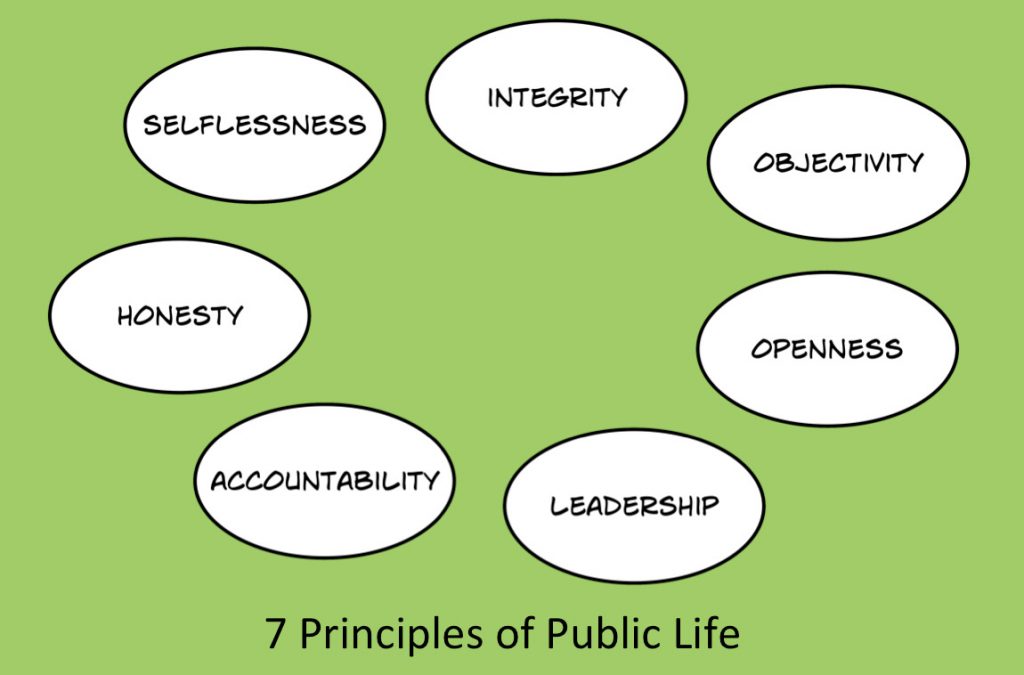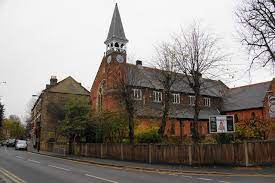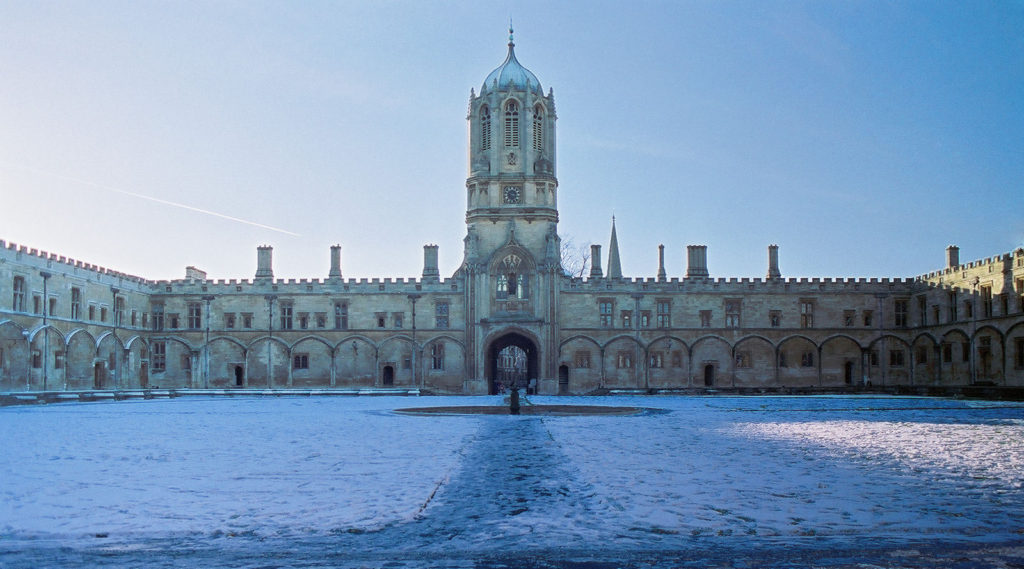
The revelations about David Cameron working for a private finance company, where standards of ethics were not of the highest, have reminded us of the Nolan Principles. These were formulated in 1995 by Lord Nolan and were offered as a statement of what was expected on those who accepted posts in government and public life. The press and opposition politicians have been revisiting these seven principals. They want to remind their audiences of the way that those in government, from the Prime Minister downwards, sometimes appear to be guilty of serious ethical lapses while carrying out their public duties. While it is not my intention here to get involved in making judgments about the behaviour of politicians and senior civil servants, I can, for the purposes of this article, remind my readers of the seven words that sum up the Nolan Principles. They are respectively Selflessness, Integrity, Objectivity, Accountability, Openness, Honesty and Leadership.
These seven principles of conduct in public life could, of course, merit a separate blog for each of them. My purpose in listing them is to remind the reader that values and principles within institutions matter. We have the right to expect that the people who represent us in public life and manage the country on our behalf follow ethical guidelines. In listing these seven principles of public life, I am aware that there is no equivalent list in church life. We do not have a statement that sets out the ethical basis for the way that, for example, church legal protocols are managed. Is the principle of openness ever compatible with Non-Disclosure Agreements that are sometimes part of legal cases connected with abuse awards? Is not the obsessive secrecy that has existed in the parts of the Church which knew about Smyth, but refused to say anything, another example of non-compliance to Nolan principles? In short, the Church needs a set of its own principles – Church Nolan Principles. These could then be appealed to whenever ethical standards are under attack or possibly being betrayed.
In thinking about the possibility of a set of principles that might help to guide the Church in the future, I realised very quickly that the Church in some areas of its life, can operate in ways that are a complete antithesis to ordinary standards of behaviour. Taking this thought further, I have come up with a set of seven negative principles that churches sometimes follow. Most of these impact on the ethical behaviour of the Church. The examples that I give of these failures of standards, could be illustrated from various areas of church life. For the purpose of this post I have chosen to make my points by looking at the recent thirtyone:eight Review on Jonathan Fletcher. It is there we can see clearly what I choose to call seven anti-principles of church life. These examples of poor behaviour each constitute a kind of shadow to the ideals that Nolan wanted to be enshrined in public life. Some of these church anti-principles were found in JF himself and many still pervade the culture that nurtured him and over which he presided to the harm of many. Let us look at each one of these, and see how they are illustrated by incidents or situations in the thirtyone:eight Review.
The first anti-principle that was revealed in the Review is the one that always gives priority to the interests of the institution over the needs of the individual. The survival and the preservation of the institution’s power, in this case the con-evo constituency, will always take precedence over everything else. We can call this anti-principle, the priority of institutional power. This first anti-principle has two aspects or sub anti-principles. The first of these is defensive in tone. It will seek to push back any challenges to the whole by a whistle-blower or any other kind of challenger. To make this defence, there are a number of powerful weapons at hand. First there is shunning and shaming, followed by threats of various kinds. The ultimate weapon is expulsion. In the case of a religious group, like the ReNew constituency, expulsion is much more threatening than just being required to leave the organisation. It has the implied threat of eternal punishment because you no longer belong to the ‘saved’ group. These various weapons of control over difficult or dissident members, have had the result that, up till now, few individual voices have been heard in this group beyond the circle of its leaders. The group entity has always prevailed in its determination to preserve the interests of the whole against those who question or challenge.
The second part of this anti-principle of group protection is the active encouragement of actions or inactions that preserve the group. This anti-principle is about doing things or not doing them so that the interests of the institution may prevail. The fulfilment of this second anti-principle is especially illustrated by the extraordinary inaction and failure of anyone in the ReNew circles to say anything about Smyth or JF. This studied passivity of an entire cohort of Christian believers went on for over forty years. It also accounts for what I referred to in a blog post as the ‘Great Silence’ that descended over the con-evo world after the offences of JF were first revealed in 2019. The Review has used one word to account for this silence, the word ‘fear’. It is this fear cultivated among insiders combined with an obsessive loyalty to the system that has helped to protect the organisation for so long. Loyalty, fear and desperate protectionism towards the system/group have pervaded the con-evo world. The institution prevailed by excluding the dissidents and whistle-blowers and by forcing loyal members to remain in passive faithful dependence.
The third anti-principle which is to be found more among the leaders of the con-evo constituency and tacitly tolerated among the followers can be summarised in this way. It is the ‘born to rule’ anti-principle. Someone has to be in charge, the reasoning goes, so those who went to the right schools/camps and knew the right people have an inbuilt and unchallengeable right to be leaders. Leaders like the current crop of ReNew leaders who have assumed power in this way, want everyone to believe that their motives for taking charge are entirely altruistic. However, there is no discernible democratic or accountable process through which to raise questions about suitability when they get things wrong. Leaders who are appointed according to the rules of nepotism and the school tie may or may not be good and altruistic. But whatever their qualities, they certainly need to be clearly accountable. The fact that JF presided over the same congregation for thirty years was likely to be extremely unhealthy for all concerned. But, being answerable to no one but himself, he could indulge his power and narcissistic needs free from any challenge.
Secrecy is another anti-principle to be discerned in the thirtyone:report. We find secrecy in mysterious meetings among ReNew leaders where no minutes were produced or any record of who was present. We can also refer to the way that the value of secrecy was sustained by the miasma of fear. It was this anti-principle of secrecy that, protected known miscreants over long periods of time. Secrecy was and is a necessary principle of the ‘school tie’ type of governance we have touched on above.
Secrecy is closely linked to another anti-principle, that of manipulation of the truth. Some of the ReNew leaders spoke of not knowing anything of the JF allegations until the early part of 2019. (+Rod Thomas has now made it clear that he knew in the autumn of 2018.) These are claims that are, frankly, difficult to believe. The Diocese of Southwark was making detailed investigations into JFs behaviour in 2016 before the PTO was withdrawn (or surrendered) at the beginning of 2017. This part of the story is important, and it is a pity that the Southwark authorities contributed, apparently, nothing to the Review. But even without the testimony of the Southwark team, it is hard for us to believe that none of the detailed enquiries into JF’s behaviour got back to the ReNew leaders. It is also difficult to imagine that a thorough investigation took place which did not involve in any way the bishop in charge of the constituency of which JF was a key leading member. We are also not helped to understand how a PTO suspension was to be enforced without anyone, not even the overseeing bishop, being told. How is anyone reading the Review to make sense of these lacunae of information? One additional fact that I have gleaned from a completely different source is that JF was ‘marched off’ one of the Iwerne camps in the summer of 2017. Even if it might possibly have been the summer of 2018, that is still something that could not have taken place except at the instruction of someone in authority. From what we know of the hierarchical system in operation in ReNew, somebody very senior was taking sanctions against JF in the summer of 2017 (or 2018). That does not fit in with the protestations of William Taylor or +Rod Thomas and the others that they only discovered in late 2018/early 2019..
The ‘orthodoxy’ of the ReNew group is seen to be an all-pervading system which does not tolerate discussion or disagreement. JF, in his own writings, showed himself keen on the notion that truth never changes. This could be seen as a pervading theological principle that is continued to this day. I want to call this an anti-principle, but I have to acknowledge that this anti-principle is not one that involves ethics or morality. Thus it is quite different from the others I have mentioned so far.
Nolan mentions, in his final point, the word leadership. By this he is drawing attention to the fact that it is important for anybody in an organisation to be able to take a lead, when necessary, to challenge bad or dishonest practice. There is little evidence of this kind of leadership in the rank and file of the con-evo world. Rather the power of intimidation, the fear of being labelled ‘unsound’ and thus to be shunned, effectively sustains the status-quo even now in the world over which JF used to preside.
I wish that that the whole Church and its constituent parts, including those under the ReNew umbrella, could aspire to something similar to the seven ethical principles of Lord Nolan. The civil service and the government of this country try to follow them, at least in theory. Even when they fail, these institutions do one better than the Church. Not only does the Church not even have an equivalent list of principles, but it often seems to operate from the negative list that I have set out. The anti-principles that I have named here, are doing and will continue to do enormous damage to our national Church.












